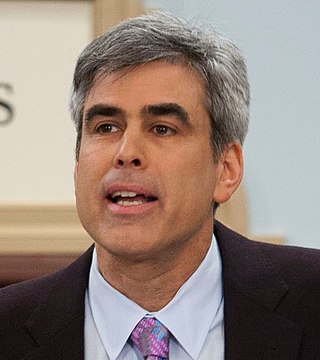Allan David Bloom was an American philosopher, classicist, and academician. He studied under David Grene, Leo Strauss, Richard McKeon, and Alexandre Kojève. He subsequently taught at Cornell University, the University of Toronto, Tel Aviv University, Yale University, the École normale supérieure, and the University of Chicago.
Moral reasoning is the study of how people think about right and wrong and how they acquire and apply moral rules. It is a subdiscipline of moral psychology that overlaps with moral philosophy, and is the foundation of descriptive ethics.
White guilt is a belief that white people bear a collective responsibility for the harm which has resulted from historical or current racist treatment of people belonging to other ethnic groups, as for example in the context of the Atlantic slave trade, European colonialism, and the genocide of indigenous peoples.
The marketplace of ideas is a rationale for freedom of expression based on an analogy to the economic concept of a free market. The marketplace of ideas holds that the truth will emerge from the competition of ideas in free, transparent public discourse and concludes that ideas and ideologies will be culled according to their superiority or inferiority and widespread acceptance among the population. The concept is often applied to discussions of patent law as well as freedom of the press and the responsibilities of the media in a liberal democracy.
The wisdom of repugnance or "appeal to disgust", also known informally as the yuck factor, is the belief that an intuitive negative response to some thing, idea, or practice should be interpreted as evidence for the intrinsically harmful or evil character of that thing. Furthermore, it refers to the notion that wisdom may manifest itself in feelings of disgust towards anything which lacks goodness or wisdom, though the feelings or the reasoning of such 'wisdom' may not be immediately explicable through reason.

Gregory Christopher Lukianoff is an American lawyer, journalist, author and activist who serves as the president of the Foundation for Individual Rights and Expression (FIRE). He previously served as FIRE's first director of legal and public advocacy until he was appointed president in 2006.

Jonathan David Haidt is an American social psychologist and author. He is the Thomas Cooley Professor of Ethical Leadership at the New York University Stern School of Business. His main areas of study are the psychology of morality and moral emotions.
Microaggression is a term used for commonplace verbal, behavioral or environmental slights, whether intentional or unintentional, that communicate hostile, derogatory, or negative attitudes toward those of different races, cultures, beliefs, or genders. The term was coined by Harvard University psychiatrist Chester M. Pierce in 1970 to describe insults and dismissals which he regularly witnessed non-black Americans inflicting on African Americans. By the early 21st century, use of the term was applied to the casual disparagement of any socially marginalized group, including LGBT people, poor people, and disabled people. Psychologist Derald Wing Sue defines microaggressions as "brief, everyday exchanges that send denigrating messages to certain individuals because of their group membership". The persons making the comments may be otherwise well-intentioned and unaware of the potential impact of their words.
The medium of television has had many influences on society since its inception. The belief that this impact has been dramatic has been largely unchallenged in media theory since its inception. However, there is much dispute as to what those effects are, how serious the ramifications are and if these effects are more or less evolutionary with human communication.
A trauma trigger is a psychological stimulus that prompts involuntary recall of a previous traumatic experience. The stimulus itself need not be frightening or traumatic and may be only indirectly or superficially reminiscent of an earlier traumatic incident, such as a scent or a piece of clothing. Triggers can be subtle, individual, and difficult for others to predict. A trauma trigger may also be called a trauma stimulus, a trauma stressor or a trauma reminder.

The term safe space refers to places "intended to be free of bias, conflict, criticism, or potentially threatening actions, ideas, or conversations". The term originated in LGBT culture, but has since expanded to include any place where a marginalized minority can come together to communicate regarding their shared experiences. Safe spaces are most commonly located on university campuses in the western world, but also are at workplaces, as in the case of Nokia.

Carol Miller Swain is an American political scientist and legal scholar who is a retired professor of political science and law at Vanderbilt University. She is a frequent television analyst and has authored and edited several books. Her interests include race relations, immigration, representation, evangelical politics, and the United States Constitution.
Moral foundations theory is a social psychological theory intended to explain the origins of and variation in human moral reasoning on the basis of innate, modular foundations. It was first proposed by the psychologists Jonathan Haidt, Craig Joseph, and Jesse Graham, building on the work of cultural anthropologist Richard Shweder. More recently, Mohammad Atari, Jesse Graham, and Jonathan Haidt have revised some aspects of the theory and developed new measurement tools. The theory has been developed by a diverse group of collaborators and popularized in Haidt's book The Righteous Mind. The theory proposes that morality is "more than one thing", first arguing for five foundations, and later expanding for six foundations :

The Righteous Mind: Why Good People are Divided by Politics and Religion is a 2012 social psychology book by Jonathan Haidt, in which the author describes human morality as it relates to politics and religion.
American Mind can refer to:

Ibram Xolani Kendi is an American author, professor, anti-racist activist, and historian of race and discriminatory policy in the U.S. He is author of books including Stamped from the Beginning, How to Be an Antiracist and Antiracist Baby. Kendi was included in Time's 100 Most Influential People of 2020.

Heterodox Academy (HxA) is a non-profit advocacy group of academics working to counteract what they see as a lack of viewpoint diversity on college campuses, especially political diversity. The organization was founded in 2015 by Jonathan Haidt, Nicholas Quinn Rosenkranz, and Chris C. Martin.
Noah Carl is a British sociologist and intelligence researcher. He was investigated and subsequently dismissed from his position as a Toby Jackman Newton Trust Research Fellow at St Edmund's College, Cambridge after over 500 academics signed a letter repudiating his research and public stance on race and intelligence, calling it "ethically suspect and methodologically flawed", and stating their concern that "racist pseudoscience is being legitimised through association with the University of Cambridge." An investigation by the college concluded that Carl's work was "poor scholarship" which violated standards of academic integrity, and that Carl had collaborated with right-wing extremists.
Cancel culture is a phrase contemporary to the late 2010s and early 2020s used to refer to a cultural phenomenon in which an individual deemed to have acted or spoken in an unacceptable manner is ostracized, boycotted, shunned, fired or assaulted, often aided by social media. This shunning may extend to social or professional circles—whether on social media or in person—with most high-profile incidents involving celebrities. Those subject to this ostracism are said to have been "canceled".
Higher education in the United States is an optional stage of formal learning following secondary education. Higher education, also referred to as post-secondary education, third-stage, third-level, or tertiary education occurs most commonly at one of the 4,360 Title IV degree-granting institutions, either colleges or universities in the country. These may be public universities, private universities, liberal arts colleges, community colleges, or for-profit colleges. US higher education is loosely regulated by several third-party organizations.







